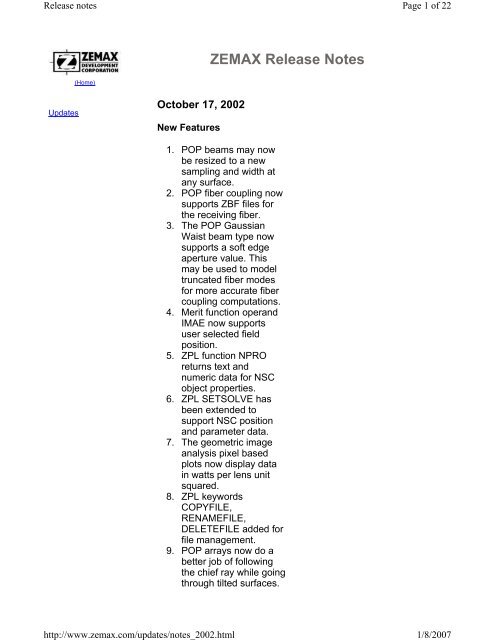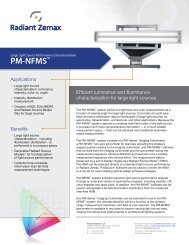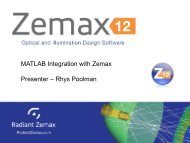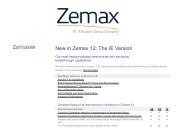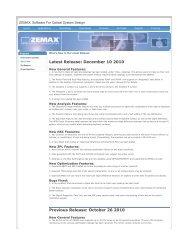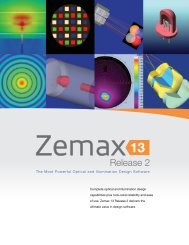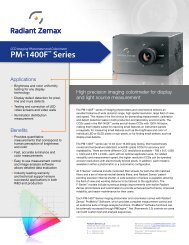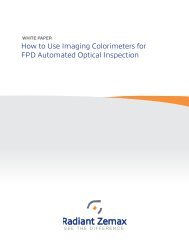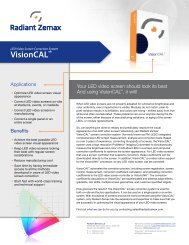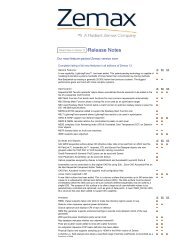2002 - Zemax
2002 - Zemax
2002 - Zemax
You also want an ePaper? Increase the reach of your titles
YUMPU automatically turns print PDFs into web optimized ePapers that Google loves.
Release noteshttp://www.zemax.com/updates/notes_<strong>2002</strong>.htmlPage 1 of 221/8/2007ZEMAX Release Notes(Home)UpdatesOctober 17, <strong>2002</strong>New Features1. POP beams may nowbe resized to a newsampling and width atany surface.2. POP fiber coupling nowsupports ZBF files forthe receiving fiber.3. The POP GaussianWaist beam type nowsupports a soft edgeaperture value. Thismay be used to modeltruncated fiber modesfor more accurate fibercoupling computations.4. Merit function operandIMAE now supportsuser selected fieldposition.5. ZPL function NPROreturns text andnumeric data for NSCobject properties.6. ZPL SETSOLVE hasbeen extended tosupport NSC positionand parameter data.7. The geometric imageanalysis pixel basedplots now display datain watts per lens unitsquared.8. ZPL keywordsCOPYFILE,RENAMEFILE,DELETEFILE added forfile management.9. POP arrays now do abetter job of followingthe chief ray while goingthrough tilted surfaces.
Release noteshttp://www.zemax.com/updates/notes_<strong>2002</strong>.htmlPage 2 of 221/8/200710. Zernike analysis nowlists peak to valley datawith tilt removed, i.e.from the centroidreference.11. POP now is capable ofusing over 1 GB ofRAM up to 2 GB forhuge arrays such as4096 x 4096.12. The CAD Export toolsupports elementswhere two surfaces areseparated by coordinatebreaks.13. Diffraction imageanalysis now plots inunits of intensity ratherthan amplitude.14. The Ohara <strong>2002</strong> glasscatalog has beenadded.15. Corning-grin dataadded to the Gradient 9Surface.Bug Fixes1. The Zernike Standardsurface was nothandled correctly forPOP analysis.2. A problem that causedthe ray-aiming algorithmto hang on untraceablerays has been repaired.September 19, <strong>2002</strong>New Features1. The "Annotate" featurenow supports arrows.2. The AXCL operand nowsupports real rays usinga user defined pupilzone, or paraxial rays.
Release noteshttp://www.zemax.com/updates/notes_<strong>2002</strong>.htmlPage 3 of 221/8/20073. New operand SPCHcomputesspherochromatism.4. New operand LONAcomputes longitudinalaberration.5. New extension keywordSetVig sets vignettingfactors.6. ZPL SETVAR nowsupports string variablearguments for codevalues.7. The Autothermalfeature now does abetter job of addingthermal pickups for allparameter data.8. MCE operands havebeen added to set theglobal polarizationstate.9. The relative illuminationXY scan plot and textnow shows thewavelength selected.10. POP now supports bulkabsorption even whennot using rays topropagate throughabsorbing media.11. NSC detectorrectangles may nowsupport coating andscattering properties.12. The glass substitutionalgorithm has beenimproved forsignificantly betterglobal optimizationwhen there are manyglasses to substitute.13. DDE operandsGetMulticon andSetMulticon haveextended functionality.14. The escape key nowterminates long Zernikecoefficient
Release noteshttp://www.zemax.com/updates/notes_<strong>2002</strong>.htmlPage 4 of 221/8/2007computations.15. Global optimization maynow be performed withno variables defined,using only glasssubstitutions.Bug Fixes1. A very rare conditioncould cause a programcrash in the ghost focusgenerator.August 26, <strong>2002</strong>New Features1. A new "offense againstthe sine condition"operand, OSCD, hasbeen added.2. The wireframe, solidmodel, and shadedmodel plots nowsupport the option tosquare edges or not.3. Zone plate surfacesmay now be mirrors.4. The POP propagationreport now checks forinadequate samplingand insufficient guardbands at every surface,and issues a warning ifdetected. Thepropagation report is adisplay option for POPtext windows.5. POP now supportsarbitrary transmissionon user definedsurfaces even ifpolarization is off.6. New optimizationoperand POPD hasbeen added to return
Release noteshttp://www.zemax.com/updates/notes_<strong>2002</strong>.htmlPage 5 of 221/8/2007data from the PhysicalOptical Propagationfeature for optimization.Supported data includefiber coupling, totalpower, peak irradiance,beam position, beamcentroid, RMS data,and encircled energy.More data may beadded in futureexpansion.7. The NSC detectorviewer now plotsradiance or luminance(power/area/solid angle)in either angle orposition space.8. More comprehensivesupport for adjustingmulti-config data whilescaling lenses andadding fold mirrors hasbeen added.9. 193.10 THz, or awavelength of 1.55252um, has been added tothe default list in theWavelength Data dialogbox.10. User defined surfaceDLL's are now passed ascaling parameter sothey may scale dataused by the DLL.Bug Fixes1. Mirrors were ignored bythe default elementtolerancing routine; thisbug was introduced inthe prior release.2. Universal plot settingssaved in NSC modecould cause programerrors in sequentialmode.3. The "out" surface on the
Release noteshttp://www.zemax.com/updates/notes_<strong>2002</strong>.htmlPage 6 of 221/8/2007Gaussian Beam Skewoptimization operandsdid not increment whensurfaces were insertedor deleted.4. ZEMAX now does abetter job of handlingtrue zero transmissiondata on glasses.5. Default decentertolerances did notrecognize elementsmade of model glasses.6. POP would add phaseof the incorrect sign oncertain mirror surfacesthat triggered atransition betweeninside and outside theRayleigh rangepropagations.7. The surface number onthe CENX and CENYoperands was notincrementing when newsurfaces were inserted.This fix required theexchanging of theSamp and Surfparameters for theseoperands.8. The nominal value ofthe TIND operand wasnot listed on thetolerance data editor.9. The physical opticsanalysis was notproperly handling raytracing through gradientindex and birefringentmedia, even if "userays" was checked.10. The tolerance TOFFoperand was not usablefor comments.July 24, <strong>2002</strong>
Release noteshttp://www.zemax.com/updates/notes_<strong>2002</strong>.htmlPage 7 of 221/8/2007New Features1. NSC objects nowsupport a "draw axis"option, which shows theorientation and positionof the object localcoordinate system.2. Operand CMVA addedto return the coatingmultipler value of anylayer.3. NSC object "asphericsurface 2" has beenadded which supportsdecentered annularelliptical andrectangular apertures.4. The "scale lens" featurehas been added to theNSC tools menu.5. A new method forcalling user definedsurface DLL's has beendefined which supportsall available lens dataeditor parameters.Bug Fixes1. The ZERN operandcould cause a programcrash duringoptimization under rarecircumstances.2. Operand CODA did notreturn an error code ifthe ray cannot betraced.3. The autothermal setupfeature may incorrectlyconsider a coordinatebreak to be a refractivesurface.4. DDE itemImportExtraData couldcause a memory error.5. The default meritfunctions were not
Release noteshttp://www.zemax.com/updates/notes_<strong>2002</strong>.htmlPage 8 of 221/8/2007constructed properlywhen toelrancing asingle configuration of amulti-config lens. Allconfigs wereconsidered, even if only1 was being toleranced.6. The thin film ray phasewas not computedcorrectly for the specialcase of very thickcoatings.July 9, <strong>2002</strong>New Features1. A new "zoom in byfactor" on the POPanalysis window makesit easier to omit theguard band from thedisplay.2. The POP window nowdisplays system,receiver, and totalcoupling for fibercomputations.3. FICP now includes thesystem transmission.4. The coating TAPRfeature now supportsrotated taper functions,and a new taper of theform of an x, y,polynomial.5. Active cursor supporthas been added to the2D Illumination plot.6. Extension itemsSetMulticon andGetMulticon have beenadded to set/retrievemulti-configuration data.7. The glass substitutiontemplate now allowsdisabling of eachtemplate test
Release noteshttp://www.zemax.com/updates/notes_<strong>2002</strong>.htmlPage 9 of 221/8/2007individually, and theuser may choose toexclude or includeglasses which have nodata provided.8. Thin film coating layerthicknesses may nowbe individually modified,optimized, andtoleranced on anysurface.9. New operand CODAallows detailed accessto coating andpolarization ray tracedata for optimization.10. The DDE itemsGetSurface andSetSurface have beenreplaced withGetSurfaceData andSetSurfaceData to allowfor better access tosurface data and easierfuture expansion.11. Tolerance operand"SEED" has beenadded to provide controlover the Monte Carlorandom numbergenerator.Bug Fixes1. The chromatic focalshift plot makes astraight line if theprimary wavelength isunder multiconfigurationeditorcontrol.2. NSC diffractive objectsdid not add phase in the"phase" column of theray database viewer orcoherent detector data.3. Parameter pick upsolves did not workfrom the object surface.
Release noteshttp://www.zemax.com/updates/notes_<strong>2002</strong>.htmlPage 10 of 221/8/20074. The Image Analysisfeature was improperlynormalizing some BIMfiles.5. The ray reflectionpolarization phasecoefficients wereimproperly computed.The field data is correct.6. Systems with severecaustics in cosinespace or hugeaberrations returnedincorrect geometric fibercoupling estimates.June 10, <strong>2002</strong>New Features1. The \MACROSdirectory for ZPLmacros now supportssubdirectories. Thisallows organization ofmacros into userdefined subdirectories.2. The POP contourdisplay now supportsuser defined contourintervals.3. Two new NSC objectshave been added Theextended polynomiallens and surface. Theseare solid and shellobjects similar to theextended polynomialsurface type.4. The "Zero phase forrelative intensity below"control has been addedto the POP ZBF Viewer.5. DDE keywordImportExtraData addedto import extra data forgrid sag and other extradata surfaces.
Release noteshttp://www.zemax.com/updates/notes_<strong>2002</strong>.htmlPage 11 of 221/8/20076. FICP operand allowsoptimization of POPfiber coupling results.7. POP fiber coupling maynow be computed withthe receiving fibercentered on theincoming beam or thesurface vertex.8. The "scatter towards"list no longerautomatically includesthe object from whichthe ray was scattered,the user is thus allowedto decide to include thescattering object or not.9. ZEMAX nowautomatically switchesfrom Index/Abbe offsetsto linear offsets fortolerancing on materialsonly defined outside thevisible band.Bug Fixes1. An infinite loop couldoccur in the glasssubstitution algorithm ifno glass can meet thetemplate specs.2. The MFE could crash ifthe default meritfunction generatedfewer operands thanwas currently displayed.3. The MCE operandMCOM did not properlytruncate comments toolong to display.4. When using polarizationto compute the FFTMTF, ZEMAX woulduse the definedwavelength weightsrather than thetransmission resultingfrom the polarization
Release noteshttp://www.zemax.com/updates/notes_<strong>2002</strong>.htmlPage 12 of 221/8/2007trace.5. The extendedpolynomial surface wasincorrectly supportingthermal pickups onvalues other than thenormalization radius.May 16, <strong>2002</strong>New Features1. New ZPL keyword POPallows physical opticspropagation analysisdata to be saved from amacro.2. ZPL function STDD andkeyword SETSTDD areused for reading/settingthe surface tilt anddecenter data.3. ZPL keyword XDIFFIAnow supports stringvariable names.4. A new source has beenadded to NSC thatsimulates a Gaussiandistribution.5. NSC detector objectsmay now be exported toCAD format files.6. NSC Coating/Scatteringgroup data is now listedon the prescriptionreport.7. The polarization pupilmap now supportsshowing data at anysurface.8. The CENX and CENYoperands now supportcomputation of thecentroid at any surface.9. The GENC operandnow supports thechoice of reference tochief ray, centroid, or
Release noteshttp://www.zemax.com/updates/notes_<strong>2002</strong>.htmlPage 13 of 221/8/2007vertex.10. A new "overall weight"may be applied to thedefault merit function toscale the weightsrelative to the userdefined operands.11. The merit functionreport now lists thedefault merit functionand user added meritfunction operands asseparate values.12. For tolerancing, theterm "criteria" is nowused instead of "meritfunction" to avoidconfusion with the meritfunction used foroptimization.13. The memory managerfor ABg data used byZEMAX has beenmodified to usesubstantially lessmemory when ABgscatter data is not beingused.14. The active cursorcoordinates have beenadded to the surfacesag and surface phasegrey scale and falsecolor plots.15. The speed of theperformance test hasbeen increased to takeless time on slowcomputers.Bug Fixes1. The transfer function forranges of surfaces inPOP could suffer fromincorrect phase scaling.2. The pop surfacetransfer function mayadd the incorrect sign of
Release noteshttp://www.zemax.com/updates/notes_<strong>2002</strong>.htmlPage 14 of 221/8/2007the phase aberrations inrefractions followingmirror spaces.3. ZPL function MCOPwas causing anincorrect syntax error.4. The ZPL NSTRcommand ignored thepolarization setting ifpolarization wasswitched off on the raytrace control dialog.5. The MTF vs. Field plotonly worked properly inconfiguration 1.6. The auto-thermal toolwas not copying over allexisting operand data.7. The lens catalog insertdid not correctly reverselenses inserted after amirror.8. The scale lens featureincorrectly scaled phaseterms on the binary 1and 2 surfaces.9. NSC Binary 2 objectswith very large phasecoefficients were notray tracing correctly.10. When splitting andscattering rays in NSCmode, the ghost anddiffracted from flagscould get mixed up.11. The prescription reportwas listing the surfacedecenter y as the xvalue.12. The consider distortionoption on extendeddiffraction imageanalysis was using theincorrect field positionto account for distortion.April 4, <strong>2002</strong>
Release noteshttp://www.zemax.com/updates/notes_<strong>2002</strong>.htmlPage 15 of 221/8/2007New Features1. Physical OpticsPropagation. Thisextensive new feature isdocumented in the newmanual.2. Surface CoordinateBreaks An alternative tousing the CoordinateBreak surface. See thenew manual for details.3. A very powerful newsurface irregularitymodel has been addedto the toleranceanalysis feature. Thenew irregularity allowsdirect specification ofthe RMS surfaceirregularity in lens units.The irregularity isimplemented usingstandard Zernike terms.Up to 231 terms areallowed, and thecoefficients are chosento yield exactly thedesired irregularity inboth sensitivity andMonte Carlo analysis.The new operand iscalled TEZI, see thenew docs for details.4. NSC Detector Viewerplots now show trueintensity in units orradiometric orphotometric units persteradian, rather thanper pixel.5. Imported SAT/IGS filesno longer are reloadedwhen changing theposition of the object,speeding upmanipulation of theseobjects.6. New ZPL keyword
Release noteshttp://www.zemax.com/updates/notes_<strong>2002</strong>.htmlPage 16 of 221/8/2007EXPORTCAD allowsIGES/STEP/SAT fileexport of lens data.7. New DDE data itemExportCad allowsIGES/STEP/SAT fileexport of lens data.Bug Fixes1. The MTF vs. Field plotwas ignoring surfacethermal multi-configdata.2. The Skew GaussianBeam feature wasignoring the effectivepropagation lengththrough grins.3. The system aperturetype paraxial workingF/# gave inaccurateresults if the EFL wasshorter than roughly10.0 units.4. The Zone platesurfaced was ignoringthe last two definedzones.March 21, <strong>2002</strong>New Features1. The Universal Plot andSlider features nowsupport all 17 surfaceparameter values.Bug Fixes1. The Tolerance Scriptcommand PERTURBcaused an abort of thescript when evaluatingthe nominal meritfunction.
Release noteshttp://www.zemax.com/updates/notes_<strong>2002</strong>.htmlPage 17 of 221/8/20072. The Universal plot didnot correctly supportExtra Data Values.3. Selecting "do not drawobject" on sourceswould also disable thedrawing of rays fromthat source.4. Very large conics couldcause the irregularsurface to fail to trace.March 4, <strong>2002</strong>New Features1. The SAT file format isnow supported for bothexport and NSC import.2. New ZPL functionMCOP returns datafrom the MCE.3. New ZPL keywordSETMCOPERAND setsdata in the MCE.4. ZPL keywordSETNSCPROPERTYnow accepts stringvariable arguments.5. The annular Zerniketerms may now becomputed up to term231.6. The detector summarynow includesunnormalized coherentintensity data.7. The grid distortion plotnow supports grids upto 100 x 100.8. ZPL Function NOBJ()added to determine thenumber of objects.Bug Fixes1. Local ray data was not
Release noteshttp://www.zemax.com/updates/notes_<strong>2002</strong>.htmlPage 21 of 221/8/20071. The glass substitutioncatalog name wasaccidentally erased onmulti-configurationglasses.2. The Focault analysiswas not properly settingdefault values.3. The RAIN/RAEDoperands were notusing the correct rayvector.January 2, <strong>2002</strong>New Features1. An NSC hologramobject has been added.The hologram may becircular or rectangular,and uses twoconstruction points todefine the hologram.2. The phase retardanceplot now shows bothreflected andtransmitted data.3. ZPL keyword GCRSsets the globalcoordinate referencesurface.Bug Fixes1. Edge thickness solveswere not automaticallyreversed wheninserting/deleting foldmirrors.2. Difficulties withincomplete data whenopening plot windows orlens files have beenfixed.See Release Notes for 2001.
Release noteshttp://www.zemax.com/updates/notes_<strong>2002</strong>.htmlPage 22 of 221/8/2007ZEMAX Development Corporation3001 112th Avenue NE, Suite 202Bellevue, WA 98004-8017 USASales:Support:Fax:E-Mail:(425) 822-3406(425) 822-1295(425) 889-4687sales@zemax.comsupport@zemax.comCopyright 2007, All Rights Reserved, ZEMAX Development Corporation


